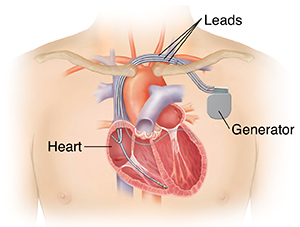- Get link
- X
- Other Apps
Most pacemakers work just when theyre needed on demand. Most pacemakers have a sensing mode that inhibits the pacemaker from sending impulses when the heartbeat is above a certain level.
/pacemakers-what-you-should-know-1745231_v2-da71dbec46b345308dd2fcbb65cc638b.png) What You Should Know About Pacemakers
What You Should Know About Pacemakers
Traditional pacemakers send the electrical pulses through wires also known as leads.

How a pacemaker works. Your pacemaker delivers an electrical impulse to help control your heart rhythm. When people refer to a pacemaker they are actually discussing a pacing system which includes the pacemaker and leads. A pacemaker helps restore the hearts rhythm by sending tiny electrical signals to the heart to increase the heart rate which relieves the symptoms of bradycardia.
A pacemaker senses through its wires what the heart is doing. Once implanted the pacemaker works by monitoring the hearts electrical activity and deciding whether and when to pace. A pacemaker system consists of a battery a computerized generator and wires with sensors called electrodes on one end.
Your pacemaker regularly checks its own battery. Wireless pacemakers are. The job of a pacemaker is to artificially take over the role of your sinus node if it isnt working properly.
It uses the same lead s to deliver a small electrical impulse to the heart to make it contract if the heart isnt going as fast as the device was programmed to maintain. A pacemaker is a small medical device that gives off electrical impulses to your heart thats placed in your chest or abdomen to correct certain heart problems and. The pacemaker is controlled by a.
Once the wires are positioned in the heart they are hooked up to the generator. A device is inserted in the body and one lead goes to the heart. 9292016 The pacemakers pulse generator sends electrical impulses to the heart to help it pump properly.
Electrical impulses are sent by the pacemaker to stimulate your heart to contract and produce a heartbeat. 1232018 A pacemaker regulates your bodys electrical system which controls your heart rhythm. Pacemaker continuously monitors the heart and if it detects a slow rhythm or an interrupted rhythm it sends electrical impulses to make the heart beat normal.
An electrode is placed next to the heart wall and small electrical charges travel through the wire to the heart. It stores and sends information about your heart for your doctor to review. If your heart rate becomes too slow the device paces by transmitting a tiny electrical signal to the heart muscle causing it to contract.
2122010 Pacemaker wires are threaded through the veins of the shoulder and guided into the heart with the help of X-rays. Today there are three basic types of pacemakers. If it senses that the heart has slowed down or missed a beat then it will send an electrical impulse to stimulate the heart to restore it to its normal rate.
Pacemaker batteries are formulated to give adequate notice before they lose their charge so you do not need to worry that your pacemaker battery will suddenly die and the pacemaker will stop working. A pace maker is a small device that is implanted under the skin most often under the collar-bone on the left or right side of the chest. Animated explanation of the mechanics of the human heart and the devices that can assist itSubscribe NOW to The Economist.
A pacemaker can often be implanted with a minor surgery. Pacemakers are powered by an internal battery that typically lasts 5 to 10 years. It consists of a pulse generator which has a battery and a tiny computer circuit and 1 or more wires known as pacing leads which attach to your heart.
With each heartbeat an electrical impulse travels. The pulse generator emits electrical impulses through the wires to your heart. How a pacemaker works A pacemaker is a small device about the size of a matchbox or smaller that weighs 20 to 50g.
Using electrical impulses they make the heart to contract. How Pacemakers Work- Pacemakers. Some pacemakers send out impulses all of the time.
Your doctor will also check the battery at your follow-up visits. A pacemaker is an electronic device which uses a lead as an antenna to sense the hearts electrical activity. The first permanent pacemaker implant happened in 1958.
The battery powers the generator and both are surrounded by a thin metal box. The wires connect the generator to the heart. Pacemakers use low-energy electrical pulses to control the rate and rhythm of your heartbeat.
 How Pacemakers Work The Economist Youtube
How Pacemakers Work The Economist Youtube
 Components And Construction Of A Pacemaker Ecg Echo
Components And Construction Of A Pacemaker Ecg Echo
 Permanent Pacemaker Insertion Hamilton Cardiology Associates New Jersey S Leading Board Certified Cardiologists
Permanent Pacemaker Insertion Hamilton Cardiology Associates New Jersey S Leading Board Certified Cardiologists
 Pacemaker Of The Heart Surgery Precautions Procedure
Pacemaker Of The Heart Surgery Precautions Procedure

 Take Heart The Pacemaker That Works Even When You Are On The Brink Of Death Daily Mail Online
Take Heart The Pacemaker That Works Even When You Are On The Brink Of Death Daily Mail Online
Permanent Pacemaker Treatment Prevention Outlook
 Pacemaker Caring For Your Child At Home
Pacemaker Caring For Your Child At Home
.ashx?h=244&la=en&mh=360&mw=520&w=220&hash=9FB84D587FA19BE63DDFD9823A53DEEF012B2EAA)
 How Pacemakers Work Boston Scientific
How Pacemakers Work Boston Scientific
 Pacemaker American Heart Association
Pacemaker American Heart Association


Comments
Post a Comment